冀教版-英语-八上-冀教版教学设计第38课:Hobbies Are Fun!
冀教版英语八年级上册:Unit 7:Lesson 38 Hobbies Are Fun!教案设计
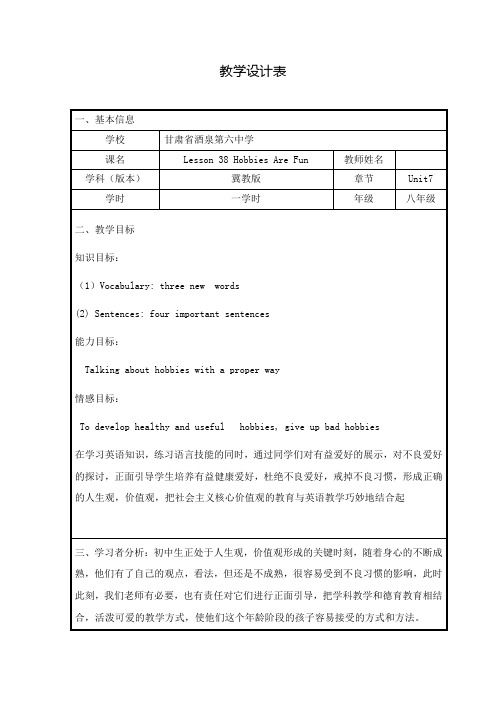
引出话题,我们该远离那些不良嗜好,升华本课主题。
复习有关爱好的词汇,skiing,drinking,sewing,playing Majiang ,smoking
探讨,回答问题
展示色彩丰富的图片,引入媒体资源,课堂更加形象生动。
Step 6.What did you know today?
1.拉幕功能在检查新单词的记忆时,遮盖了单词让学生来在同板写出,便于检查,便于对比。
2.白板书写功能的应用,便于批阅,突出重点。
3.音频文件的导入,便于老师操作,不用录音机磁带,省事,省力,省钱。
Step4.
Showand Tell
(22’10”-33’25”)
通过优美的舞姿,动听的歌声,活泼的运动感染同学们,激发他们培养健康有益的爱好。
教学设计表
一、基本信息
学校
甘肃省酒泉第六中学
课名
Lesson38 Hobbies Are Fun
教师姓名
学科(版本)
冀教版
章节
Unit7
学时
一学时
年级
八年级
二、教学目标
知识目标:
(1)Vocabulary: three new words
(2) Sentences: four important sentences
在学习英语知识,练习语言技能的同时,通过同学们对有益爱好的展示,对不良爱好的探讨,正面引导学生培养有益健康爱好,杜绝不良爱好,戒掉不良习惯,形成正确的人生观,价值观,把社会主义核心价值观的教育与英语教学巧妙地结合起
五、教学设计
教学环节
起止时间(”-’”)
环节目标
教学内容
学生活动
媒体作用及分析
冀教初中英语八上《Lesson 38 Hobbies Are Fun!》word教案 (1).doc
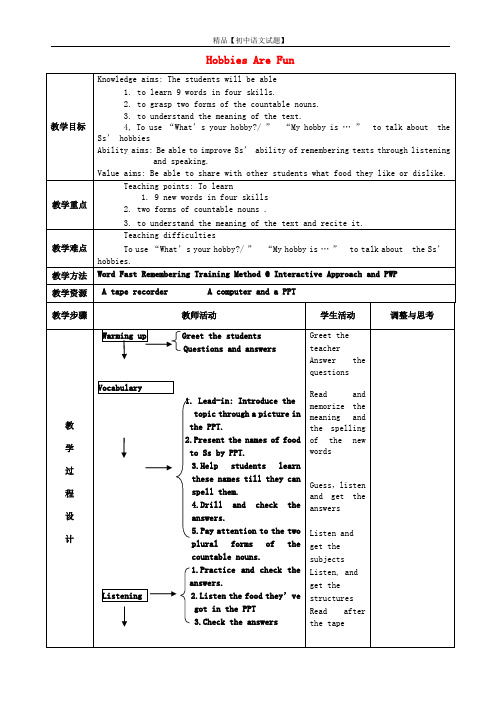
Teaching points: To learn 1. 9 new words in four skills
2. two forms of countable nouns .
Think about
what they’ve
learnt and
speak them
out.
Try to use it.
Make a survey
about S’s
parents about
food they
like
or
dislike.
设 计
Homework
3.Check the answers.
调整与思考
精品【初中语文试题】
Learn the dialogue 1.Present the three sentence Practice
structures.
according to
2.Practice
and the pictures.
Task
教 学 过
Summary 程
drilling. (替换法) 3.Listen to the dialogue
精品【初中语文试题】
Hobbies Are Fun
教学目标 教学重点
Knowledge aims: The students will be able
1. to learn 9 words in four skills. 2. to grasp two forms of the countable nouns. 3. to understand the meaning of the text. 4, To use “What’s your hobby?/ ” “My hobby is … ” to talk about the Ss’ hobbies Ability aims: Be able to improve Ss’ ability of remembering texts through listening
冀教版-英语-八上-第38课 Hobbies Are Fun

英语
课题
Lesson 38: Hobbies Are Fun!
主备人
审核人
学案
类型
学案
编号
学习目标
知识与能力:Key words and phrases:
confidencen.自信postcardn.明信片outdoor adj.户外的,露天的
not only …but also…take up
1.not only… but also…
He plays not only the piano but also the violin.
他不仅弹钢琴,也拉小提琴。
Not only the teacher but also the students were against the plan.不仅那位老师,还有学生们都反对那项计划。
2.take up开始感兴趣
Eg:At the age of sixty he took up the study of Russian.
在60岁时他开始学习俄语。
When did Joan first take up music?
琼是什么时候开始对音乐感兴趣的?
He left the job in the city to take up farming.
他辞去市里的工作,开始务农。
3.confidencen.自信
He is always full of confidence in everything.
他总是对每一件事充满信心。
三.Practise
Ⅰ.根据句意及汉语提示,完成句子。
1. The book is from the library. Don’t(标记) it with a pen.
冀教版八年级英语上册Lesson38【教案】
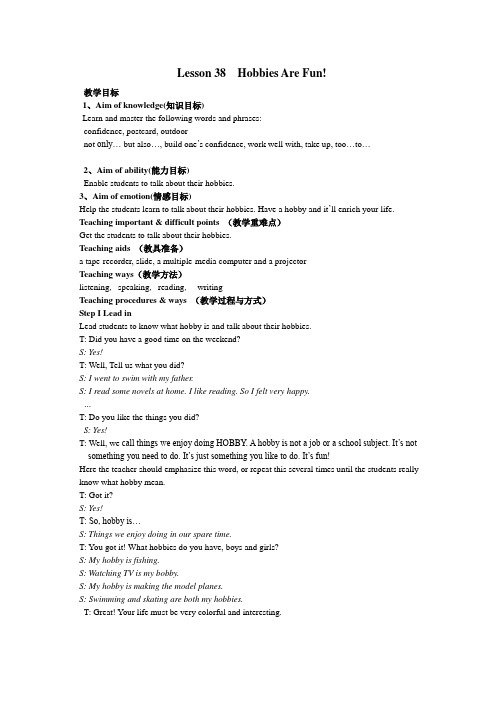
Lesson 38 Hobbies Are Fun!教学目标1、Aim of knowledge(知识目标)Learn and master the following words and phrases:confidence, postcard, outdoornot only… but also…, build one’s confidence, work well with, take up, too…to…2、Aim of ability(能力目标)Enable students to talk about their hobbies.3、Aim of emotion(情感目标)Help the students learn to talk about their hobbies. Have a hobby and it’ll enrich your life. Teaching important & difficult points (教学重难点)Get the students to talk about their hobbies.Teaching aids (教具准备)a tape-recorder, slide, a multiple-media computer and a projectorTeaching ways(教学方法)listening, speaking, reading, writingTeaching procedures & ways (教学过程与方式)Step I Lead inLead students to know what hobby is and talk about their hobbies.T: Did you have a good time on the weekend?S: Yes!T: Well, Tell us what you did?S: I went to swim with my father.S: I read some novels at home. I like reading. So I felt very happy.…T: Do you like the things you did?S: Yes!T: Well, we call things we enjoy doing HOBBY. A hobby is not a job or a school subject. It’s not something you need to do. It’s just something you like to do. It’s fun!Here the teacher should emphasize this word, or repeat this several times until the students really know what hobby mean.T: Got it?S: Yes!T: So, hobby is…S: Things we enjoy doing in our spare time.T: You got it! What hobbies do you have, boys and girls?S: My hobby is fishing.S: Watching TV is my bobby.S: My hobby is making the model planes.S: Swimming and skating are both my hobbies.T: Great! Your life must be very colorful and interesting.Step II ListeningGet the students to listen to the tape and get some basic information of this conversation.T: Listen to the tape and answer the questions on the slide.1. What types of hobbies are mentioned in the text?2. What new hobby do you like? Why?Sample answers:1. Collections, outdoor activities, games, arts.2. ….Step III ReadingAsk the students to read the dialogue. Explain some language points to help them have a further understanding of the text.Language points:1. not only…but also…的用法用于连接两个表示并列关系的成分,着重强调后者,其意为“不仅……而且……”。
冀教版八上Lesson38HobbiesAreFun!教学设计

(2)进阶任务:学生运用一般现在时,用英语描述自己和他人的兴趣爱好,如“She enjoys reading books.”、“He likes playing football.”等。
3.视频拍摄:鼓励学生拍摄一段关于自己或家人、朋友爱好的短视频,用英语进行解说。视频时长不超过3分钟,要求画面清晰,语音标准。
4.词汇积累:学生自主收集关于爱好的英语词汇,并整理成词汇表。要求至少包含10个单词,并注明单词的词性和中文意思。
5.语法练习:完成课后练习册中关于一般现在时的练习题,巩固语法知识。
3.运用任务型教学法,设计不同难度的任务,使学生在完成任务的过程中,逐步提高英语听说读写技能。
4.教师关注学生的学习过程,及时给予反馈和指导,帮助学生发现并纠正语言错误,提高语言运用能力。
(三)情感态度与价值观
1.学生通过学习本课,认识到拥有兴趣爱好对个人成长的重要性,培养积极、健康的兴趣爱好。
2.学生在交流过程中,学会尊重他人的选择,培养包容、友善的品质。
3.教师强调拥有兴趣爱好对个人成长的重要性,并鼓励学生在日常生活中多尝试、多体验,丰富自己的业余生活。
4.最后,教师布置课后作业,要求学生用英语采访家人或朋友,了解Байду номын сангаас们的兴趣爱好,并用一般现在时进行描述。此举旨在巩固课堂所学,提高学生的实际应用能力。
五、作业布置
为了巩固本节课的学习内容,培养学生的实践应用能力,特布置以下作业:
冀教版八上Lesson38HobbiesAreFun!教学设计
一、教学目标
(一)知识与技能
英语 冀教版 八年级上册(教案)Unit 7 Enjoy Your Hobby Lesson 38
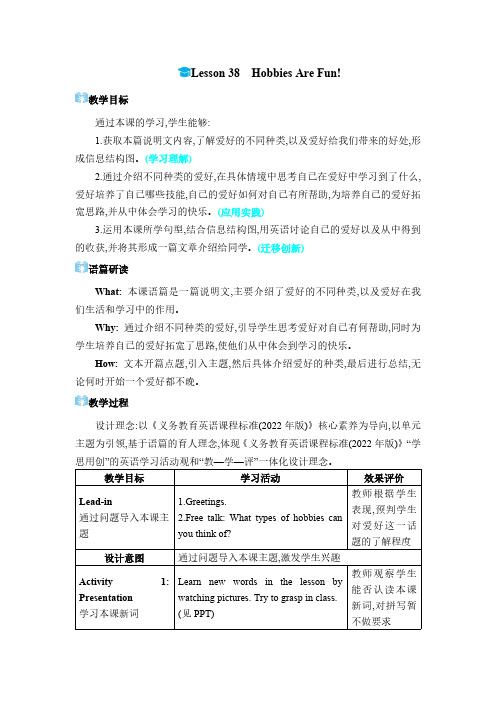
Lesson38Hobbies Are Fun!教学目标通过本课的学习,学生能够:1.获取本篇说明文内容,了解爱好的不同种类,以及爱好给我们带来的好处,形成信息结构图。
(学习理解)2.通过介绍不同种类的爱好,在具体情境中思考自己在爱好中学习到了什么,爱好培养了自己哪些技能,自己的爱好如何对自己有所帮助,为培养自己的爱好拓宽思路,并从中体会学习的快乐。
(应用实践)3.运用本课所学句型,结合信息结构图,用英语讨论自己的爱好以及从中得到的收获,并将其形成一篇文章介绍给同学。
(迁移创新)语篇研读What:本课语篇是一篇说明文,主要介绍了爱好的不同种类,以及爱好在我们生活和学习中的作用。
Why:通过介绍不同种类的爱好,引导学生思考爱好对自己有何帮助,同时为学生培养自己的爱好拓宽了思路,使他们从中体会到学习的快乐。
How:文本开篇点题,引入主题,然后具体介绍爱好的种类,最后进行总结,无论何时开始一个爱好都不晚。
教学过程设计理念:以《义务教育英语课程标准(2022年版)》核心素养为导向,以单元主题为引领,基于语篇的育人理念,体现《义务教育英语课程标准(2022年版)》“学思用创”的英语学习活动观和“教—学—评”一体化设计理念。
教学目标学习活动效果评价Lead-in通过问题导入本课主题1.Greetings.2.Free talk:What types of hobbies canyou think of?教师根据学生表现,预判学生对爱好这一话题的了解程度设计意图通过问题导入本课主题,激发学生兴趣Activity1: Presentation学习本课新词Learn new words in the lesson bywatching pictures.Try to grasp in class.(见PPT)教师观察学生能否认读本课新词,对拼写暂不做要求设计意图通过图片和设置的情景能更好地帮助学生理解、掌握本课单词【学习理解】Activity2:Listening 听前预测,听中获取有用信息Listen the lesson and match the nameswith the hobbies.(题见PPT)Then check the answers.教师观察学生是否有准确获取有用信息的能力,并给出指导设计意图通过听力练习,在复习上节课内容的基础上,了解本课主题,并培养学生使用听中抓取关键词、速记等能力完成听力任务【学习理解】Activity3:While-reading通过速读和细节阅读,对文本内容进行深度解析Read the lesson and finish Exercise1onpage101.Then,cheek the answers inclass.教师观察学生能否准确获取并理解文章的细节,把握学生内化所学内容和语言的情况设计意图通过分层次阅读文本,一步一步理解课文内容【学习理解】Activity4:Retell根据思维导图,复述本课内容Fill in the blanks and try to retell thelesson.(见PPT)教师倾听学生的展示,并根据实际情况给出指导设计意图通过复述课文内容,整体把握文章思路,深刻理解主题,整体使用语言素材。
冀教版八年级上册Lesson38HobbiesAreFun说课稿

在教学过程中,我预见到可能出现的问题和挑战包括:学生对一般现在时态的疑问句和否定句的掌握程度不一,部分学生可能对英语学习存在恐惧心理等。针对这些问题,我将采取以下应对措施:
1.对不同水平的学生给予不同的指导和帮助,鼓励他们积极参与课堂活动。
2.通过鼓励和激励,提高学生的自信心,消除他们的恐惧心理。
(二)教学目标
1.知识与技能:
能够正确运用一般现在时态描述自己的兴趣爱好和时间安排;能够听懂、说出一篇关于兴趣爱好和时间的短文。
2.过程与方法:
3.情感态度与价值观:
培养学生对不同文化的尊重和理解,引导学生正确看待和处理个人兴趣与时间的关系。
(三)教学重难点
1.教学重点:
(1)词汇:hobby、interest、time、weekend等。
三、教学方法与手段
(一)教学策略
在本节课中,我主要采用交际法、任务驱动法和小组合作法进行教学。交际法强调语言的实际运用,通过模拟真实情境让学生进行交流,提高他们的口语表达能力。任务驱动法通过设定具体任务,激发学生的学习兴趣和动机,培养他们的自主学习能力和问题解决能力。小组合作法鼓励学生之间的互动与合作,培养他们的团队精神和沟通能力。这些方法的选取基于现代教育理念,注重学生的主体地位和全面发展。
4.写作练习:让学生写一篇关于自己兴趣爱好的短文,锻炼他们的写作能力。
(四)总结反馈
在总结反馈阶段,我将引导学生自我评价,并提供有效的反馈和建议。首先,我会让学生回顾本节课所学的知识点,提问他们是否能用自己的话进行表达。然后,我会根据学生的回答,给予积极的反馈和鼓励,并提出一些建议,帮助他们改进。最后,我会布置一些课后作业,让学生进一步巩固所学知识。
(五)作业布置
冀教版八年级英语上册Lesson38HobbiesAreFun教学设计
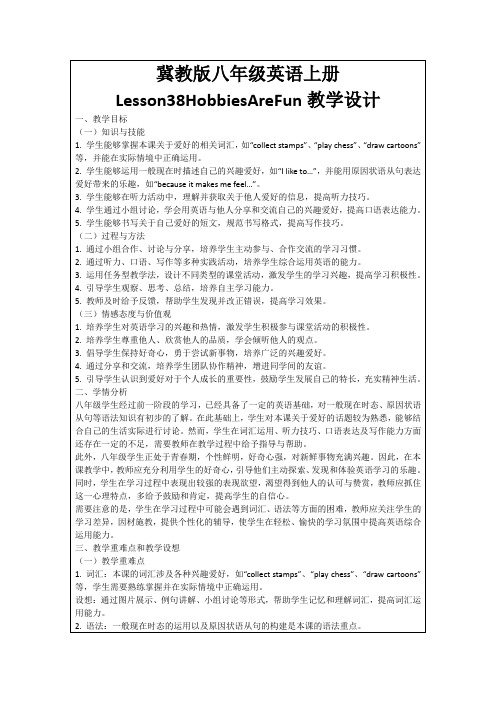
设想:设计丰富的语境,让学生在实际运用中掌握语法知识,如通过小组活动,让学生互相询问和描述各自的兴趣爱好。
3.听力:学生需要从听力材料中获取关于他人爱好的信息。
设想:采用任务型听力教学,引导学生通过预测、听记、核对等步骤,提高听力技巧。
2.学生跟读对话,注意模仿语音、语调,提高口语表达能力。
3.教师讲解一般现在时态和原因状语从句的用法,结合实例进行说明,让学生在实际语境中感受语法知识的应用。
4.教师组织学生进行角色扮演,练习对话中的句型和表达,巩固所学知识。
(三)学生小组讨论(500字)
1.教师将学生分成小组,要求他们用英语讨论以下问题:“What are your hobbies? Why do you like them?”
3.教师组织口语练习,让学生模拟真实场景,与他人交流兴趣爱好。
4.学生进行写作练习,书写关于自己爱好的短文,注意文章结构的合理性。
(五)总结归纳(500字)
1.教师引导学生回顾本课所学内容,总结一般现在时态和原因状语从句的用法。
2.学生分享学习心得,互相交流学习过程中遇到的困难和解决方法。
3.教师强调本课重点,提醒学生注意词汇、语法等方面的易错点。
2.学生在小组内分享自己的兴趣爱好,并尝试用一般现在时态和原因状语从句进行表达。
3.教师巡回指导,关注学生的发音、词汇、语法等方面,给予及时反馈和纠正。
4.各小组选代表进行汇报,展示小组讨论成果。
(四)课堂练习(500字)
1.教师设计听力练习,让学生听录音,获取关于他人爱好的信息,提高听力技巧。
2.学生完成相关的词汇、语法练习,巩固所学知识。
2.培养学生尊重他人、欣赏他人的品质,学会倾听他人的观点。
冀教版初中英语八年级上第七单元-Lesson 38 Hobbies Are Fun
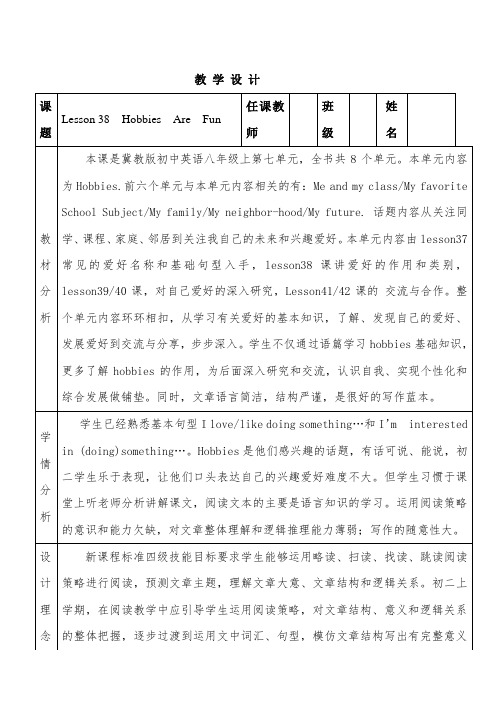
Hobbies Are Fun There ...types of hobbies. ...like to collect ..interested in outdoor…
What?..A lot of enjoy playing games.
难点
运用所学短语和句型,学习文章结构,仿写有关兴趣爱好的话题段落、短文。
教法
1.任务教学法;
2.导学案--先学后教模式。
学法
运用阅读技巧:读标题猜测文章主题;读各段首句掌握文章大意;通过上下文和构词法学习生词。
通过分析文章和段落的写作特点,句句之间的连接词,学习围绕一个中心句写一段话的写作方法。
提供网络链接,引导学生正面利用互联网,查阅了解更多兴趣爱好,为认识并培养兴趣爱好做铺垫。
2. 流利朗读课文,了解文章大意;记住有关兴趣爱好句型;
3. 理解文章大意和写作特点,并运用文中语言知识描写自己或亲朋的爱好;
4. 引导学生正面利用互联网,查阅了解更多兴趣爱好,为认识并培养兴趣爱好做铺垫。
重点
1. 阅读课文,了解文章大意;理解有关兴趣爱好句型;并撰写自己的爱好;
2. 学习生词Confidence,take up, Outdoor, postcard;熟悉兴趣爱好的种类;
share what they have learned.
2. Read and rememberthenew words.
3. Show and solve the problems.
Step3.
Frame-
work
T: 1. Show the5-questions clue of the passage.
冀教版英语八年级上册Lesson38HobbiesAreFun!教学设计
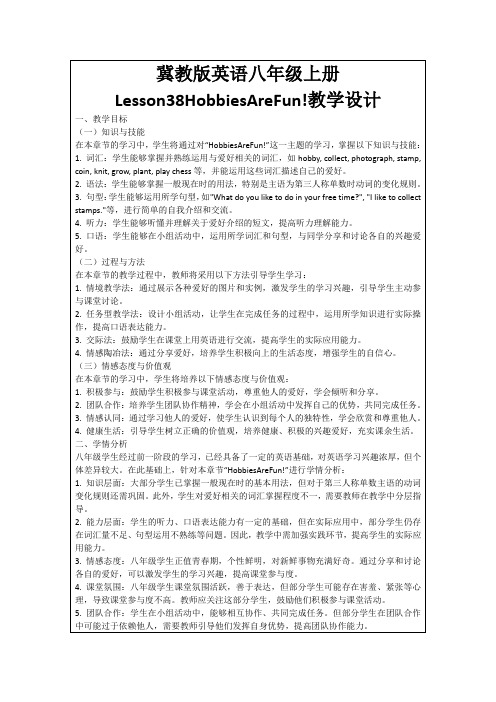
3.句型:学生能够运用所学句型,如"What do you like to do in your free time?", "I like to collect stamps."等,进行简单的自我介绍和交流。
4.听力:学生能够听懂并理解关于爱好介绍的短文,提高听力理解能力。
5.反思与总结:
-鼓励学生在课后进行自我反思,总结本节课的学习收获和不足之处。
-学生可以以日记、学习心得等形式进行总结,以便教师了解学生的学习状况,为下一步教学提供参考。
3.情感态度:八年级学生正值青春期,个性鲜明,对新鲜事物充满好奇。通过分享和讨论各自的爱好,可以激发学生的学习兴趣,提高课堂参与度。
4.课堂氛围:八年级学生课堂氛围活跃,善于表达,但部分学生可能存在害羞、紧张等心理,导致课堂参与度不高。教师应关注这部分学生,鼓励他们积极参与课堂活动。
5.团队合作:学生在小组活动中,能够相互协作、共同完成任务。但部分学生在团队合作中可能过于依赖他人,需要教师引导他们发挥自身优势,提高团队协作能力。
3.情感认同:通过学习他人的爱好,使学生认识到每个人的独特性,学会欣赏和尊重他人。
4.健康生活:引导学生树立正确的价值观,培养健康、积极的兴趣爱好,充实课余生活。
二、学情分析
八年级学生经过前一阶段的学习,已经具备了一定的英语基础,对英语学习兴趣浓厚,但个体差异较大。在此基础上,针对本章节“HobbiesAreFun!”进行学情分析:
3.词汇练习:
-教师提供一份包含本节课所学词汇的练习,要求学生完成填空、选择等任务,巩固词汇记忆。
-学生可以自主设计关于爱好的词汇卡片,包括单词、音标、例句等,以便于复习和分享。
冀教英语八上Unit 7 Lesson 38 Hobbies Are Fun! 教案

Unit 7 Lesson 38 Hobbies Are Fun! 教案Ⅰ. Aim of knowledgeLearn and master the words and phrases: hobby, guess, sell, wall, frame, instruction, roll, a roll of film, enjoy doing, bring…to…Ⅱ. Aim of abilityEnable students to talk about their hobbies.Ⅲ. Aim of emotionHelp the students learn to talk about their hobbies. Have a hobby and it’ll enrich your life.Ⅳ. Teaching important & difficult pointsGet the students to talk about their hobbies.Ⅴ. Teaching aidsA tape-recorder, slide, a multiple-media computer and a projector.Ⅵ. Teaching procedures & waysStep I Lead inLead students to know what hobby is and talk about their hobbies.T: Did you have a good time on the weekend?S: Yes!T: Well, Tell us what you did?S: I went to swim with my father.S: I read some novels at home. I like reading. So I felt very happy.…T: Do you like the things you did?S: Yes!T: Well, we call things we enjoy doing HOBBY. A hobby is not a job or a school subject. It’s not something you need to do. It’s just something you like to do. It’s fun!Here the teacher should emphasize this word, or repeat this several times until the students really know what hobby mean.T: Got it?S: Yes!T: So, hobby is…S: Things we enjoy doing in our spare time.T: You got it! What hobbies do you have, boys and girls?S: My hobby is fishing.S: Watching TV is my bobby.S: My hobby is making the model planes.S: Swimming and skating are both my hobbies.T: Great! Your life must be very colorful and interesting.Step II ListeningGet the students to listen to the tape and get some basic information of this text.Step III Reading1. Ask the students to read the dialogue. Explain some language points to help them have a further understanding of this conversation and ask them to then act it out.2. PracticingGet the students to make their own dialogue according to this text.Sample dialogue:S1: Good morning, Can I help you? / What can I do for you?S2: I’d like to buy a radio.S1: What about this one? It’s handy, and it is a well-known radio.S2: How much is it?S1: 60 Yuan, sir. I am afraid it is much too expensive. Will you show me another type?S2: Have a look at this one, then. It is only 36 Yuan.S1: OK I will take it.T: Excellent! Let’s give them a big hand.Step IV ProjectGet students to talk about their hobbies in groups of four according to Project. And then ask some groups to act their dialogues out.Ⅶ. HomeworkDo exercises in Activity Book.。
冀教版-英语-八上-教案:第38课:hobbies are fun
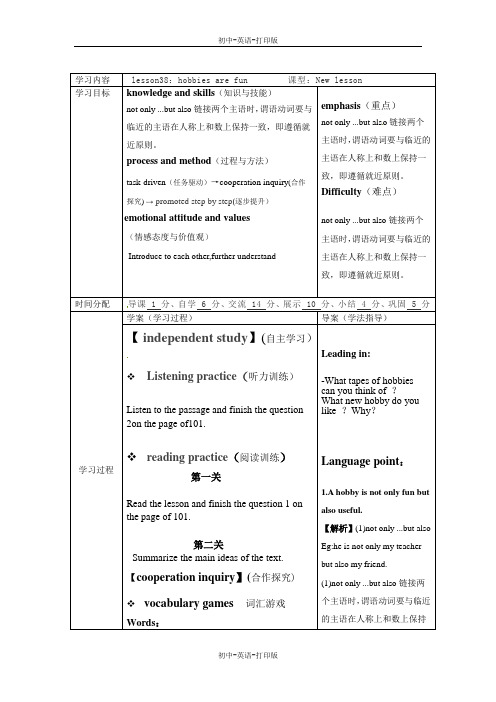
学习内容 lesson38:hobbies are fun 课型:New lesson 学习目标knowledge and skills(知识与技能)not only ...but also链接两个主语时,谓语动词要与临近的主语在人称上和数上保持一致,即遵循就近原则。
process and method(过程与方法)task-driven(任务驱动)→cooperation inquiry(合作探究) → promoted step by step(逐步提升)emotional attitude and values(情感态度与价值观)Introduce to each other,further understand emphasis(重点)not only ...but also链接两个主语时,谓语动词要与临近的主语在人称上和数上保持一致,即遵循就近原则。
Difficulty(难点)not only ...but also链接两个主语时,谓语动词要与临近的主语在人称上和数上保持一致,即遵循就近原则。
时间分配导课 1 分、自学 6 分、交流 14 分、展示 10 分、小结 4 分、巩固 5 分学习过程学案(学习过程)导案(学法指导)【 independent study】(自主学习)❖ Listening practice(听力训练)Listen to the passage and finish the question2on the page of101.❖ reading practice(阅读训练)第一关Read the lesson and finish the question 1 onthe page of 101.第二关Summarize the main ideas of the text.【cooperation inquiry】(合作探究)❖vocabulary games 词汇游戏Words:Leading in:-What tapes of hobbiescan you think of ?What new hobby do youlike ?Why?Language point:1.A hobby is not only fun butalso useful.【解析】(1)not only ...but alsoEg:he is not only my teacherbut also my friend.(1)not only ...but also链接两个主语时,谓语动词要与临近的主语在人称上和数上保持confidence n 自信postcard n 明信片outdoor adj 户外的,露天的Phrases:Not only 。
冀教版英语八年级上册Lesson38HobbiesAreFun!说课稿

(四)总结反馈
在总结反馈阶段,我将采取以下措施:
1.自我评价:让学生回顾本节课所学内容,对自己的学习情况进行自我评价,反思自己的优点和不足。
2.同伴互评:组织学生相互评价,提出建议和意见,促进彼此之间的学习交流。
3.教师评价:针对学生的表现,给予针对性的反馈和建议,鼓励学生继续努力,提高英语水平。
(五)作业布置
课后作业布置如下:
1.复习本节课所学词汇和句型,进行口头练习,巩固知识点。
2.完成一份关于自己爱好的英语小报,要求使用一般现在时态描述,提升学生的写作能力。
3.预习下一课内容,为课堂学习做好准备。
作业的目的是:1.巩固课堂所学知识,提高学生的英语应用能力;2.培养学生的自主学习意识,养成良好的学习习惯;3.提前了解下一课内容,提高课堂学习效果。
二、学情分析导
(一)学生特点
本节课面向的八年级学生,年龄大约在14岁左右,他们正处于青春期,思维活跃,好奇心强,对于新鲜事物有较高的接受能力。在认知水平上,他们已经具备了一定的英语基础,能够理解和运用一些基础词汇和语法结构。在学习兴趣方面,学生对与生活紧密相关的话题较感兴趣,爱好类话题能够引起他们的共鸣。在学习习惯上,学生已逐渐形成了合作学习和探究学习的习惯,但仍有部分学生依赖性强,自主学习能力有待提高。
四、教学过程设计
(一)导入新课
为了快速吸引学生的注意力和兴趣,我将采用以下方式导入新课:
1.以学生熟悉的生活场景引入:通过展示一组学生日常生活中常见的爱好图片,如踢足球、弹钢琴等,让学生用英语说出这些爱好,为新课的学习做好铺垫。
2.创设情境:播放一段关于不同人群谈论各自爱好的英语视频,让学生观看并思考:What are their hobbies? How do they talk about their hobbies?从而激发学生的学习兴趣和好奇心。
冀教版八年级上册Lesson38HobbiesAreFun教学设计
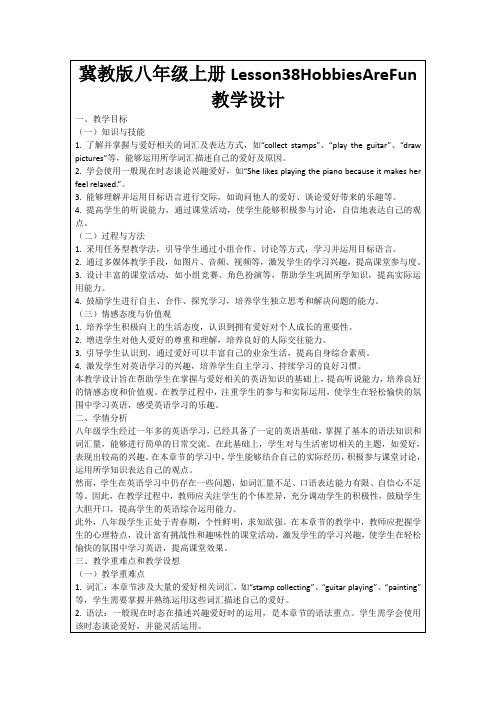
4.提高学生的听说能力,通过课堂活动,使学生能够积极参与讨论,自信地表达自己的观点。
(二)过程与方法
1.采用任务型教学法,引导学生通过小组合作、讨论等方式,学习并运用目标语言。
2.通过多媒体教学手段,如图片、音频、视频等,激发学生的学习兴趣,提高课堂参与度。
2.教师提问:“What do you like to do in your free time?”,让学生进行头脑风暴,分享自己的爱好,并鼓励他们用英语进行表达。
3.教师在黑板上列出学生所提到的爱好,同时引入本节课的重点词汇,如“stamp collecting”、“guitar playing”等,让学生初步了解并记忆这些词汇。
二、学情分析
八年级学生经过一年多的英语学习,已经具备了一定的英语基础,掌握了基本的语法知识和词汇量,能够进行简单的日常交流。在此基础上,学生对与生活密切相关的主题,如爱好,表现出较高的兴趣。在本章节的学习中,学生能够结合自己的实际经历,积极参与课堂讨论,运用所学知识表达自己的观点。
然而,学生在英语学习中仍存在一些问题,如词汇量不足、口语表达能力有限、自信心不足等。因此,在教学过程中,教师应关注学生的个体差异,充分调动学生的积极性,鼓励学生大胆开口,提高学生的英语综合运用能力。
2.结合自己的爱好,撰写一篇短文,介绍自己的爱好及原因。要求学生使用本节课所学的词汇和句型,字数在100-120词左右。
3.观看一段关于爱好的英语视频,如YouTube上的“Top 10 Hobbies That Make You Smarter”,并总结视频中提到的爱好及其益处。学生需用英语列出至少5个爱好,并简要说明每个爱好的优点。
八年级英语上册 Unit 7 Lesson 38 Hobbies Are Fun教案 (新版)冀教版

Unit 7 Lesson 38 Hobbies Are FunⅠ. Aim of knowledgeLearn and master the words and phrases: hobby, guess, sell, wall, frame, instruction, roll, a roll of film, enjoy doing, bring…to…Ⅱ. Aim of abilityEnable students to talk about their hobbies.Ⅲ. Aim of emotionHelp the students learn to talk about their hobbies. Have a hobby and it’ll enrich your life.Ⅳ. Teaching important & difficult pointsGet the students to talk about their hobbies.Ⅴ. Teaching aidsA tape-recorder, slide, a multiple-media computer and a projector.Ⅵ. Teaching procedures & waysStep I Lead inLead students to know what hobby is and talk about their hobbies.T: Did you have a good time on the weekend?S: Yes!T: Well, Tell us what you did?S: I went to swim with my father.S: I read some novels at home. I like reading. So I felt very happy.…T: Do you like the things you did?S: Yes!T: Well, we call things we enjoy doing HOBBY. A hobby is not a job or a school subject. It’s not something you need to do. It’s just something you like to do. It’s fun! Here the teacher should emphasize this word, or repeat this several times until the students really know what hobby mean.T: Got it?S: Yes!T: So, hobby is…S: Things we enjoy doing in our spare time.T: You got it! What hobbies do you have, boys and girls?S: My hobby is fishing.S: Watching TV is my bobby.S: My hobby is making the model planes.S: Swimming and skating are both my hobbies.T: Great! Your life must be very colorful and interesting.Step II ListeningGet the students to listen to the tape and get some basic information of this text. Step III Reading1. Ask the students to read the dialogue. Explain some language points to help them have a further understanding of this conversation and ask them to then act it out.2. PracticingGet the students to make their own dialogue according to this text.Sample dialogue:S1: Good morning, Can I help you? / What can I do for you?S2: I’d like to buy a radio.S1: What about this one? It’s handy, and it is a well-known radio.S2: How much is it?S1: 60 Yuan, sir. I am afraid it is much too expensive. Will you show me another type?S2: Have a look at this one, then. It is only 36 Yuan.S1: OK I will take it.T: Excellent! Let’s give them a big hand.Step IV ProjectGet students to talk about their hobbies in groups of four according to Project. And then ask some groups to act their dialogues out.Ⅶ. HomeworkDo exercises in Activity Book.。
八年级英语上册 Unit 7 Lesson 38 Hobbies Are Fun教案 (新版)冀教版
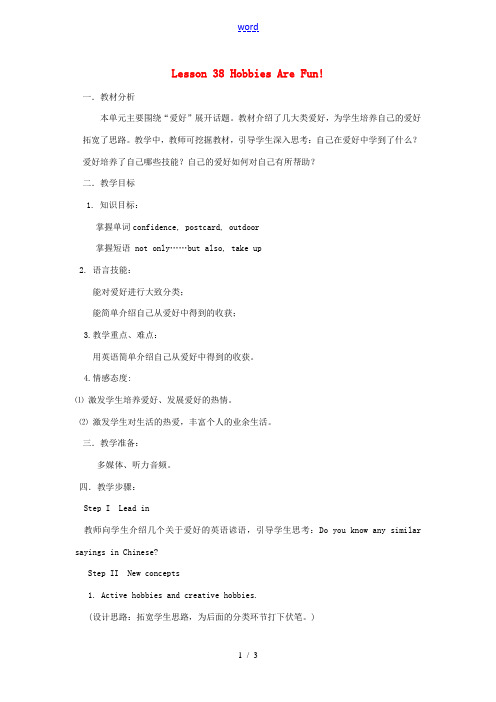
Lesson 38 Hobbies Are Fun!一.教材分析本单元主要围绕“爱好”展开话题。
教材介绍了几大类爱好,为学生培养自己的爱好拓宽了思路。
教学中,教师可挖掘教材,引导学生深入思考:自己在爱好中学到了什么?爱好培养了自己哪些技能?自己的爱好如何对自己有所帮助?二.教学目标1. 知识目标:掌握单词confidence, postcard, outdoor掌握短语 not only……but also, take up2. 语言技能:能对爱好进行大致分类;能简单介绍自己从爱好中得到的收获;3.教学重点、难点:用英语简单介绍自己从爱好中得到的收获。
4.情感态度:⑴激发学生培养爱好、发展爱好的热情。
⑵激发学生对生活的热爱,丰富个人的业余生活。
三.教学准备:多媒体、听力音频。
四.教学步骤:Step I Lead in教师向学生介绍几个关于爱好的英语谚语,引导学生思考:Do you know any similar sayings in Chinese?Step II New concepts1. Active hobbies and creative hobbies.(设计思路:拓宽学生思路,为后面的分类环节打下伏笔。
)2. Listen to the passage and finish the following exercises.学生先阅读题目要求,再听录音。
录音听两遍,之后请几位学生回答。
(设计思路:训练学生有目的地倾听的能力,对课文内容进行初步了解。
)3. Task-based Reading.学生默读课文,根据题目要求完成练习。
(设计思路:训练学生有目的地阅读、获取信息的能力。
由于本课生词较少且易于理解,因此学生先通过听、读接触生词,进行猜测,随后教师再进行讲解,学生验证自己理解得是否准确,鼓励学生在具体语境中猜测、理解语言。
)4. Read the lesson again and organize the hobbies into the following groups.学生再次阅读课文,将爱好归类。
(新)冀教版八年级上册 Lesson 38(公开课)教案

Lesson 38 Hobbies Are Fun!Teaching content:1. Mastery words and expressions2. Oral words and expressionsTeaching aims:1. Cooperate with others and finish the task.2. Write one’s hobby in English.Teaching important points:1. Talk about likes and dislikes.2. Talk about sequence.Teaching difficult points:verb-ingTeaching preparation:flashcardsTeaching aids:Audiotape, flashcardsType of lesson:new lessonTeaching procedures:Step 1. Let the students show their hobbies to the class. Ask them to introduce their hobbies in detail. Are there any students who have the same hobbies?Let them exchange their experience.Step 2. Listen to the tape and answer the following questions:1. What types of hobbies can you think of?2. What new hobby do you like? Why?Step 3. Read the text silently then check the answers. Then read the text loudly in roles.Step 4. Listen to the tape and read after it until the students can read it fluently.Step 5. Come to “Gardening with Mary〞Step 6. Listen to the tape and read after it until the students can read it fluently.Homework:Work in pairs. Organize the hobbies into the following groups.第二课时Teaching content:1. Mastery words and expressions.2. Oral words and expressions.Teaching aims:1. Have confident in yourself.2. Cultivate the students’ abilities of learning by themselves.Teaching important points:1. Find one’s virtues and improve the interest of learning English.2. Learn to introduce yourself.Teaching difficult points:project pronouns, possessive pronouns and reflexive pronounsTeaching preparation:flashcardsTeaching aids:audiotape, flashcardsType of lesson:new lessonTeaching procedures:Step 1. Make sentences with project pronouns, possessive pronouns and reflexive pronouns. Some able students can say a passage and sum the pronouns with the students.Record some meaningful sentences and analyze them. Write some sentences including mistakes on the blackboard. Let the students correct them together.Then introduce yourself and answer “Who are you?〞Step 2. Listen to the tape and read after it. Let the students have a further discussion about the text.1. What’s Li Ming good at?2. How does Danny help Li Ming?3. Does his teacher also give him some advice?Step 3. Come to “PROJECT〞We have learned many words about our talents. So the task is easy to the class. The students can write outlines first. Show your photographs to your partners. If you can’t write the report like Li Ming, you can ask others for advice.Divide the class into several groups. What do they like about each plan?What would they change? What illustrates or photographs will they use?Instruct students to revise their outlines, as needed. Make sure students use what they have learned in their discussion and communication with one another.If the project cannot be finished in one lesson, it can last for two or three lesson.Homework:Describe yourself and why you are unique.Write a report about yourselfwith drawings or photographs.Summary:The best way to learn English is to use what we learn. This task in this lesson is to use the phrases that we learned in these lessons. Show their photographs to the others. It is a very good way to stimulate students’ interests of learning English. Help them to finish the task. Display the result in the English Corner.。
